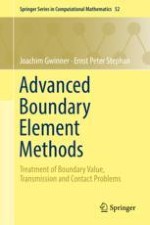This book is devoted to the mathematical analysis of the numerical solution of boundary integral equations treating boundary value, transmission and contact problems arising in elasticity, acoustic and electromagnetic scattering. It serves as the mathematical foundation of the boundary element methods (BEM) both for static and dynamic problems. The book presents a systematic approach to the variational methods for boundary integral equations including the treatment with variational inequalities for contact problems. It also features adaptive BEM, hp-version BEM, coupling of finite and boundary element methods – efficient computational tools that have become extremely popular in applications.
Familiarizing readers with tools like Mellin transformation and pseudodifferential operators as well as convex and nonsmooth analysis for variational inequalities, it concisely presents efficient, state-of-the-art boundary element approximations and points to up-to-date research.
The authors are well known for their fundamental work on boundary elements and related topics, and this book is a major contribution to the modern theory of the BEM (especially for error controlled adaptive methods and for unilateral contact and dynamic problems) and is a valuable resource for applied mathematicians, engineers, scientists and graduate students.
